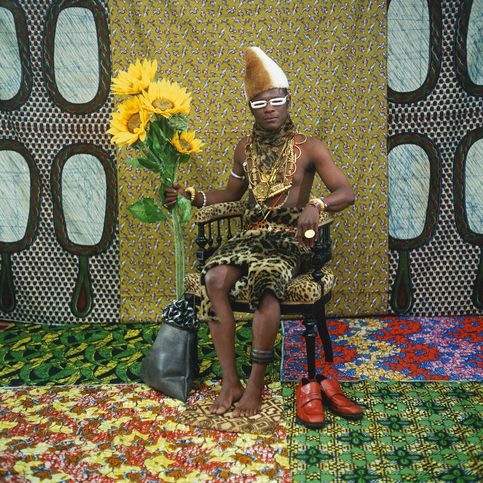Le Chef qui a vendu l’Afrique aux colons

Samuel Fosso
Le Chef qui a vendu l’Afrique aux colons, 1997
d'une serie de 'Tati'
Color photograph digital c-print, laminated on dibond 124.5 x 124.5 cm, framed 127.5 x 127.5 cm Edition 3/3
GF0031835.00.0-2021
Artwork text
In the Generali Foundation Collection, Le Chef qui a vendu l'Afrique aux colons [The Chief who Sold Africa to the Colonists], 1997 from the series Tati, 1997 is one of Samuel Fosso's best known works. It is part of a series the artist created for the Tati clothing stores in Paris. In this garish, opulent scene, Fosso appears as a fictional African ruler, proudly presenting us with African trappings of power and, at the same time, symbols of Western luxury. He is enthroned on a colonial upholstered chair covered with cheetah fur. Scarf and loincloth are in leopard look. In addition to traditional necklaces, arm and leg bracelets, some of which are studded with shells, he wears heavy gold jewelry and a hat made of soft fur that may be inspired by Congolese dictator Mobutu. His bare feet rest on a small rug between a pair of red men's knickers and a black bag, both made of leather, in keeping with Western fashion. The backdrop is Dutch wax fabrics, commonly associated with exoticism in terms of their colorfulness and patterning, and identified as typically African. In fact, the batik technique used to make them was invented in Indonesia. The Dutch and British started mass production in the 19th century and exported the fabrics to West Africa. It was only after colonial occupation was overcome that these fabrics could become an important expression of African culture and national identity, even though they are multicultural. The dominant colors of green, yellow and red correspond to the colors of the Pan-African movement and represent the richness of nature, the love of Africa and the blood spilled in African history. Grinning triumphantly, this ruler holds out to us a huge bouquet of sunflowers, an ephemeral trophy. He gazes through white sunglasses that are more than an extravagant accessory. In this self-portrait, Fosso plays with clichés of the Western idea of corrupt African rulers. The artist does not shy away from presenting a wickedly satirical tableau of critical self-reflection in which he denounces African dictators who, in order to gain and maintain their power and for personal enrichment, sold and betrayed their country, its precious resources, and even their countrymen to white colonizers and were active supporters of the slave trade. This self-portrait tells a story of blacks and whites with an unsparing conclusion for both sides. (Doris Leutgeb)